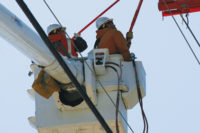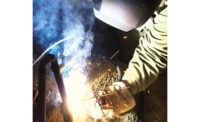Luckily, one of the most pervasive trends in the FRC industry today is the growth of FR clothing style options. This trend, driven by the realization that fabric styles at comparable weights provide comparable protection, poses one of the largest opportunities to drive end user satisfaction in 2014 and beyond.
The role of FR fabrics
The FR fabric plays an integral role in a finished FR garment’s performance, affecting as much as 90 percent of the overall safety level and comfort. Fabric also controls key characteristics like:
- Flame resistance and durability of flame resistance (in combination with quality seam construction for finished garments)
- Arc flash and flash fire protection
- Softness
- Degree of warmth
- Breathability
- Shrinkage
- Wear life of the product
- Resistance to wrinkling
Recent years have yielded innovations in fabric weave and knit design that have led to increased protection-to-weight ratios — a higher arc rating per unit of weight:
- While traditional woven fabrics have been constructed in a plain-weave or 3x1 twill configuration, sateen weave fabrics utilize a “double plate” sateen construction, saving as much as an ounce of weight for comparable protection.
- By either using an interlock knit style or producing a “tight jersey,” fabric manufacturers have successfully increased protection per ounce and reduced shrinkage over traditional FR jersey knit fabrics.
- Focused on reducing injury rates, the utility industry was the first to identify that the vast majority of single-layer FR fabrics provide comparable arc flash protection. This revelation led to the understanding that:
- Heavier fabrics hold more heat in and block more heat from the hazard.
- Lighter fabrics let more heat escape, and let more heat through from the hazard.
- And, although it’s difficult to consistently replicate the flash fire hazard in a laboratory environment, the existing consensus standards for flash fire protection point to a similar relationship between fabric weight and protective capacity.
- Once you accept the parity in protection between competing FR fabrics at comparable weights, it becomes clear that other factors should be considered:
- Evaluate FR fabrics based on comfort, softness, durability, style, breathability characteristics.
- Offer employee-level choice of multiple fabrics, as many of the evaluation factors are subjective and vary from individual to individual.
FR clothing style advancements
The realization that the majority of FR fabrics provide comparable protection at a given fabric weight has largely commoditized the protective aspects of FR clothing. As a result, FR garment manufacturers have focused on traditional, “mainstream” style attributes to differentiate their products. Today’s flame-resistant work wear is becoming as wearable as the clothing users choose to wear off-the-clock.
Here is a look at the future of FRC — and how far it has come since NFPA 70E, National Electric Safety Code (NESC), and OSHA 1910.269 began increasingly mandating its use in the early 2000’s:
Traditional Work Wear Style
Select work wear manufacturers are bringing the style of traditional work wear to FRC work wear. As a result, hallmark characteristics like durability, comfort and fit common in leading “rugged” work wear have become increasingly common in today’s FRC.
Western Flare
Some FRC manufacturers have drawn inspiration from the western-style clothing common in the Southwest and applied it to FRC. In fact, traditional western wear manufacturers are introducing and expanding lines of FRC. Look for FR shirts with western front and back yokes and snap closures, and relaxed cut FR jeans with leg openings designed to accommodate boots.
Sport Performance
Other FRC manufacturers have emulated the success of the popular Under Armour® brand*, known for its compression and wicking garments designed for athletes. Lightweight, fitted garments offering antimicrobial moisture management and designed for layering are the hallmarks of Sport Performance FRC lines, which emphasize breathability and comfort while protecting the wearer from arc flash and flash fire hazards.
Outdoor Adventure
Some FRC lines are bringing the look and performance of outdoor sportswear lines like The North Face® to the FR marketplace.* Designed for “extreme” outdoor conditions in the spirit of adventure, these manufacturers offer cold-weather FRC to keep workers warm and compliant with workplace safety standards.
Outdoor Sports
FRC manufacturers are also narrowing the gap between what FRC workers have to wear and clothing they want to wear by paralleling “weekend wear”— clothing styles traditionally seen in hunting, fishing, and camping, for example. Manufacturers have introduced FR shirts that incorporate camouflage into protective apparel. Due to popular demand, many manufacturers have plaid patterns under development as well.
As new styles are continually introduced and the gap between retail and FRC styles continues to shrink, workers can choose from a variety of FR styles and fabrics, which drives end-user satisfaction, comfort and compliance.
*Under Armour and The North Face® are registered trademarks of Under Armour, Inc. and The North Face, Inc., respectively.





